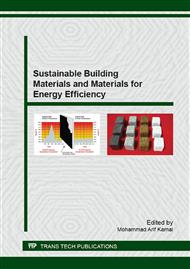[1]
Ministry of the Environment and Water Resource, Key Environmental Statistics (2011).
Google Scholar
[2]
Ferreira C, Ribeiro A, Ottosen L. Possible Applications for Municipal Solid Waste Fly Ash. JHazard Mater 2003; 96(2-3): 201-216.
DOI: 10.1016/s0304-3894(02)00201-7
Google Scholar
[3]
Lam CHK, Ip AWM, Barford JP, McKay G. Use of Incineration MSW Ash: A Review. Sustainability 2010; 2(7): 1943-(1968).
DOI: 10.3390/su2071943
Google Scholar
[4]
Shih PH, Chang JE, Chiang LC. Replacement of raw mix in cement production by municipal solid waste incineration ash. CemConcr Res 2003; 33: 1831-1836.
DOI: 10.1016/s0008-8846(03)00206-0
Google Scholar
[5]
Kikuchi R. Recycling of municipal solid waste for cement production: pilot-scale test for transforming incineration ash of solid waste into cement clinker. ResourConservRecycl 2001; 31: 137-147.
DOI: 10.1016/s0921-3449(00)00077-x
Google Scholar
[6]
Vegas I, Ibañez JA, San José JT, Urzelai A. Construction demolition wastes, Waelz slag and MSWI bottom ash: a comparative technical analysis as material for road construction, Waste Manage, 2008; 28: 565-574.
DOI: 10.1016/j.wasman.2007.01.016
Google Scholar
[7]
Birgisdóttir H, Bhander G, Hauschild MZ, Christensen TH. Life cycle assessment of disposal of residues from municipal solid waste incineration: recycling of bottom ash in road construction or landfilling in Denmark evaluated in the ROAD-RES model, Waste Manage, 2007; 27: S75-S84.
DOI: 10.1016/j.wasman.2007.02.016
Google Scholar
[8]
Åberg A, Kumpiene J, Ecke H. Evaluation and prediction of emissions from a road built with bottom ash from municipal solid waste incineration (MSWI), Sci Tot Env 2006; 355: 1-12.
DOI: 10.1016/j.scitotenv.2005.03.007
Google Scholar
[9]
Forteza R, Far M, Seguı C, Cerdá V. Characterization of bottom ash in municipal solid waste incinerators for its use in road base. Waste Manage 2004; 24: 899-909.
DOI: 10.1016/j.wasman.2004.07.004
Google Scholar
[10]
Ferraris M, Salvo M, Ventrella A, Buzzi L, Veglia M. Use of vitrified MSWI bottom ashes for concrete production. Waste Manage 2009; 29: 1041-1047.
DOI: 10.1016/j.wasman.2008.07.014
Google Scholar
[11]
Bertolini L, Carsana M, Cassago D, QuadrioCurzio A, Collepardi M. MSWI ashes as mineral additions in concrete. CemConcr Res 2004; 34: 1899-(1906).
DOI: 10.1016/j.cemconres.2004.02.001
Google Scholar
[12]
Müller U, Rübner K. The microstructure of concrete made with municipal waste incinerator bottom ash as an aggregate component. CemConcr Res 2006; 36: 1434-1443.
DOI: 10.1016/j.cemconres.2006.03.023
Google Scholar
[13]
Pera J, Coutaz L, Ambroise J, Chababbet M. Use of incinerator bottom ash in concrete. CemConcr Res 1997; 27: 1-5.
DOI: 10.1016/s0008-8846(96)00193-7
Google Scholar
[14]
Lam CHK, Ip AWM, Barford JP, McKay G. Use of incineration MSW ash: a review. Sustainability 2010; 2: 1943-(1968).
DOI: 10.3390/su2071943
Google Scholar
[15]
Jurič B, Hanžič L, Ilić R, Samec N. Utilization of municipal solid waste bottom ash and recycled aggregate in concrete. Waste Manage 2006; 26: 1436-1442.
DOI: 10.1016/j.wasman.2005.10.016
Google Scholar
[16]
Astrup T, Rosenblad C, Trapp S, Christensen TH. Chromium release from waste incineration air-pollution-control residues. EnvironSciTechnol 2005; 39(9): 3321-3329.
DOI: 10.1021/es049346q
Google Scholar
[17]
Cai Z, Chen D, Lundtorp K, Christensen TH. Evidence of Al–Cr interactions affecting Cr-leaching from waste incineration ashes. Waste Manage 2003; 23(1): 89-95.
DOI: 10.1016/s0956-053x(02)00113-7
Google Scholar
[18]
Aubert JE, Husson B, VaquierA. Metallic aluminum in MSWI fly ash: quantification and influence on the properties of cement-based products. Waste Manage 2004; 24(6): 589-596.
DOI: 10.1016/j.wasman.2004.01.005
Google Scholar
[19]
Mizutani S, Sakai SI, Takatsuki H. Investigation of hydrogen generation from municipal solid waste incineration fly ash. J Mater Cycles Waste Manage 2000; 2(1): 16-23.
Google Scholar
[20]
Jawed I, Skalny J. Alkalies in cement: a review: II. Effects of alkalies on hydration and performance of Portland cement. Cem Con Res 1987; 8: 37-52.
DOI: 10.1016/0008-8846(78)90056-x
Google Scholar
[21]
Chen X, Lu C. Effect of alkali on hydration process and properties of cement. J Chinese Ceramic Society 1993; 1(4): 301-308.
Google Scholar
[22]
Mindess S, Young JF, Darwin D. Concrete 2nd ed, Prentice Hall New Jersey, (2002).
Google Scholar


